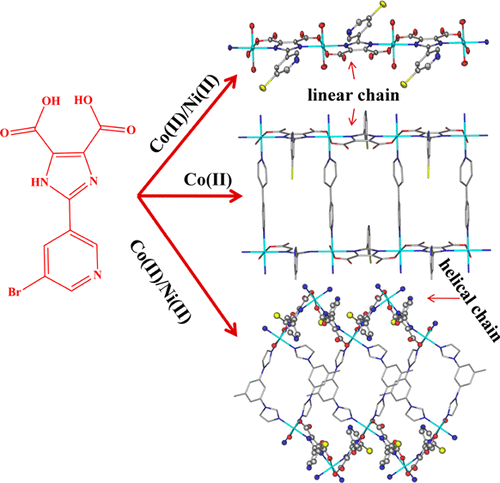当前位置:
X-MOL 学术
›
Cryst. Growth Des.
›
论文详情
Our official English website, www.x-mol.net, welcomes your
feedback! (Note: you will need to create a separate account there.)
Coordination Frameworks Containing Magnetic Single Chain of Imidazoledicarboxylate-Bridged Cobalt(II)/Nickel(II): Syntheses, Structures, and Magnetic Properties
Crystal Growth & Design ( IF 3.2 ) Pub Date : 2018-05-14 00:00:00 , DOI: 10.1021/acs.cgd.8b00174 Wenbo Wang 1 , Ruiying Wang 2 , Lina Liu 1 , Benlai Wu 1
Crystal Growth & Design ( IF 3.2 ) Pub Date : 2018-05-14 00:00:00 , DOI: 10.1021/acs.cgd.8b00174 Wenbo Wang 1 , Ruiying Wang 2 , Lina Liu 1 , Benlai Wu 1
Affiliation

|
Five new magnetic coordination frameworks with formulas of {[Co2(HL)2(H2O)4]·4H2O}n (1), {[Ni2(HL)2(H2O)4]·4H2O}n (2), [Co(HL)(bpy)]n (3), [Co(HL)(pbim)]n (4), and [Ni(HL)(pbim)]n (5) [H3L = 2-(5-bromo-pyridin-3-yl)-1H-imidazole-4,5-dicarboxylic acid, bpy = 4,4′-bipyridine, and pbim = 1,1′-(5-methyl-1,3-phenylene)bis(1H-imidazole)] have been synthesized and structurally characterized by elemental, thermogravimetric, and X-ray diffraction analyses. In all compounds, the doubly deprotonated (HL)2– ligands adopt the same μ-kN,O:kN′,O′ coordination mode, showing very interesting coordination orientation in the construction of those coordination polymers. Complexes 1 and 2 feature (HL)2–-bridged linear chain structures. Complex 3 is a 2D network with (4,4) grids built up from the (HL)2–-bridged linear chains observed in 1 being further linked by rod-like bpy bridges replacing the coordination of water molecules. Those almost or completely linear chains formed by the bis-N,O-chelation of the imidazoledicarboxylate of (HL)2– in 1–3 are rarely observed in the complexes of 4,5-imidazoledicarboxylic acid and its derivatives, giving a typical structure model to investigate the magnetic exchange-coupling mediated by imidazoledicarboxylate. Isostructural complexes 4 and 5 are 2D helicates where (HL)2–-bridged left- and right-handed helixes are doubly linked into the mesolayer structures with 63 topology through the further coordination of angular spacers pbim. Remarkably, the formation of (HL)2–-bridged linear chains or helical chains is mainly dependent on the trans- or cis-chelation of two (HL)2– ligands around the same metal center, which could be finely tuned by the structural features of auxiliary ligands used. Magnetostructural analyses disclose that the bis-N,O-chelating imidazoledicarboxylates of (HL)2– transmit antiferromagnetic interactions along the (HL)2–-bridged metal–organic chains with the spin-coupling constants of −4.89, −17.8,–6.55, −7.35, and −19.6 cm–1 for 1–5, respectively. Notably, the μ-kN,O:kN′,O′ coordination mode of (HL)2– ligand dominates the assembly of metal–organic frameworks as well as the magnetic exchange between the paramagnetic ions in those magnetic chains, but the magnetic exchange-coupling depends strongly on the nature of the metal center.
中文翻译:

含咪唑二羧酸盐桥连钴(II)/镍(II)磁性单链的配位骨架:合成,结构和磁性
五个新的具有{[Co 2(HL)2(H 2 O)4 ]·4H 2 O} n(1),{[Ni 2(HL)2(H 2 O)4 ]·4H }的磁性配位框架2 O} n(2),[Co(HL)(bpy)] n(3),[Co(HL)(pbim)] n(4)和[Ni(HL)(pbim)] n(5) [H 3 L = 2-(5-溴-吡啶-3-基)-1 H-咪唑-4,5-二羧酸,bpy = 4,4'-联吡啶,pbim = 1,1'-(5-甲基-1,3-亚苯基)双(1 H-咪唑)]在结构上通过元素分析,热重分析和X射线衍射分析来表征。在所有化合物中,双去质子化(HL)2-配体采用相同的μ- k N,O:k N',O'配位模式,在这些配位聚合物的结构中显示出非常有趣的配位方向。配合物1和2具有(HL)2-桥连的线性链结构。复杂物3是一个2D网络,其中有(4,4)个网格是由(HL)2-桥接线性链在图1进一步通过杆状bpy桥连接,取代了水分子的配位。由双-形成的那些几乎或完全直链Ñ,Ô(HL)的imidazoledicarboxylate的-chelation 2-在1 - 3在4,5- imidazoledicarboxylic酸及其衍生物的复合物很少观察到,给人一种典型结构模型研究咪唑二羧酸盐介导的磁交换耦合。同构复合物4和5是2D螺旋结构,其中(HL)2-桥联的左手和右手螺旋与6 3双重连接到中间层结构中通过角间隔子pbim的进一步协调来实现拓扑结构。值得注意的是,(HL)2-桥连的线性链或螺旋链的形成主要取决于围绕同一金属中心的两个(HL)2-配体的反式或顺式螯合,这可以通过结构的微调来实现。使用的辅助配体的特征。磁结构分析表明,(HL)2–的双-N,O螯合咪唑二羧酸盐沿(HL)2 –桥联的金属有机链传递反铁磁相互作用,自旋耦合常数为−4.89,−17.8,–6.55 ,−7.35和−19.6 cm –1 for 1–分别为5。值得注意的是,(HL)2-配体的μ- k N,O:k N',O'配位模式主导着金属有机骨架的组装以及这些磁链中顺磁性离子之间的磁交换,但是磁交换耦合在很大程度上取决于金属中心的性质。
更新日期:2018-05-14
中文翻译:

含咪唑二羧酸盐桥连钴(II)/镍(II)磁性单链的配位骨架:合成,结构和磁性
五个新的具有{[Co 2(HL)2(H 2 O)4 ]·4H 2 O} n(1),{[Ni 2(HL)2(H 2 O)4 ]·4H }的磁性配位框架2 O} n(2),[Co(HL)(bpy)] n(3),[Co(HL)(pbim)] n(4)和[Ni(HL)(pbim)] n(5) [H 3 L = 2-(5-溴-吡啶-3-基)-1 H-咪唑-4,5-二羧酸,bpy = 4,4'-联吡啶,pbim = 1,1'-(5-甲基-1,3-亚苯基)双(1 H-咪唑)]在结构上通过元素分析,热重分析和X射线衍射分析来表征。在所有化合物中,双去质子化(HL)2-配体采用相同的μ- k N,O:k N',O'配位模式,在这些配位聚合物的结构中显示出非常有趣的配位方向。配合物1和2具有(HL)2-桥连的线性链结构。复杂物3是一个2D网络,其中有(4,4)个网格是由(HL)2-桥接线性链在图1进一步通过杆状bpy桥连接,取代了水分子的配位。由双-形成的那些几乎或完全直链Ñ,Ô(HL)的imidazoledicarboxylate的-chelation 2-在1 - 3在4,5- imidazoledicarboxylic酸及其衍生物的复合物很少观察到,给人一种典型结构模型研究咪唑二羧酸盐介导的磁交换耦合。同构复合物4和5是2D螺旋结构,其中(HL)2-桥联的左手和右手螺旋与6 3双重连接到中间层结构中通过角间隔子pbim的进一步协调来实现拓扑结构。值得注意的是,(HL)2-桥连的线性链或螺旋链的形成主要取决于围绕同一金属中心的两个(HL)2-配体的反式或顺式螯合,这可以通过结构的微调来实现。使用的辅助配体的特征。磁结构分析表明,(HL)2–的双-N,O螯合咪唑二羧酸盐沿(HL)2 –桥联的金属有机链传递反铁磁相互作用,自旋耦合常数为−4.89,−17.8,–6.55 ,−7.35和−19.6 cm –1 for 1–分别为5。值得注意的是,(HL)2-配体的μ- k N,O:k N',O'配位模式主导着金属有机骨架的组装以及这些磁链中顺磁性离子之间的磁交换,但是磁交换耦合在很大程度上取决于金属中心的性质。











































 京公网安备 11010802027423号
京公网安备 11010802027423号